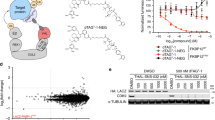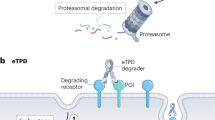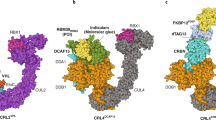Abstract
Protein depletion is a key approach to understanding the functions of a protein in a biological system. We recently developed the Trim-Away approach in order to rapidly degrade endogenous proteins without prior modification. Trim-Away is based on the ubiquitin ligase and Fc receptor TRIM21, which recognizes antibody-bound proteins and targets them for degradation by the proteasome. In a typical Trim-Away experiment, protein degradation is achieved in three steps: first, introduction of an antibody against the target protein; second, recruitment of endogenous or exogenous/overexpressed TRIM21 to the antibody–bound target protein; and third, proteasome-mediated degradation of the target protein, antibody and TRIM21 complex. Protein degradation by Trim-Away is acute and rapid, with half-lives of ~10–20 min. The major advantages of Trim-Away over other protein degradation methods are that it can be applied to any endogenous protein without prior modification; that it uses conventional antibodies that are widely available; and that it can be applied to a wide range of cell types, including nondividing primary human cells, for which other loss-of-function assays are challenging. In this protocol, we describe the detailed procedures for antibody preparation and delivery in mouse oocytes and cultured cells via microinjection and electroporation. In addition, we provide recommendations for antibody selection and validation, and for the generation of TRIM21-overexpressing cell lines for cases in which endogenous TRIM21 is limited. A typical Trim-Away experiment takes just a few hours.
This is a preview of subscription content, access via your institution
Access options
Access Nature and 54 other Nature Portfolio journals
Get Nature+, our best-value online-access subscription
$29.99 / 30 days
cancel any time
Subscribe to this journal
Receive 12 print issues and online access
$259.00 per year
only $21.58 per issue
Buy this article
- Purchase on Springer Link
- Instant access to full article PDF
Prices may be subject to local taxes which are calculated during checkout




Similar content being viewed by others
Change history
30 November 2018
In the version of this paper originally published, the present address of W.A. McEwan was accidentally omitted. This address (UK Dementia Research Institute, Department of Clinical Neurosciences, University of Cambridge, Cambridge, UK) has now been added as affiliation 3, and the equal-contributions note has been updated to affiliation 4. These changes are reflected in the PDF and HTML versions of the protocol.
References
Gaj, T., Gersbach, C. A. & Barbas, C. F. ZFN, TALEN and CRISPR/Cas-based methods for genome engineering. Trends Biotechnol. 31, 397–405 (2013).
Boettcher, M. & McManus, M. T. Choosing the right tool for the job: RNAi, TALEN or CRISPR. Mol. Cell 58, 575–585 (2015).
Eisen, J. S. & Smith, J. C. Controlling morpholino experiments: don’t stop making antisense. Development 135, 1735–1743 (2008).
Toyama, B. H. et al. Identification of long-lived proteins reveals exceptional stability of essential cellular structures. Cell 154, 971–982 (2013).
Rao, P. N. & Engelberg, J. Mitotic duration and its variability in relation to temperature in HeLa cells. Exp. Cell Res. 52, 198–208 (1968).
Weiss, W. A., Taylor, S. S. & Shokat, K. M. Recognizing and exploiting differences between RNAi and small-molecule inhibitors. Nat. Chem. Biol. 3, 739–744 (2007).
El-Brolosy, M. A. & Stainier, D. Y. R. Genetic compensation: a phenomenon in search of mechanisms. PLoS Genet. 13, e1006780 (2017).
Banaszynski, L. A. et al. A rapid, reversible, and tunable method to regulate protein function in living cells using synthetic small molecules. Cell 126, 995–1004 (2006).
Neklesa, T. K. et al. Small-molecule hydrophobic tagging-induced degradeation of HaloTag fusion proteins. Nat. Chem. Biol. 7, 538–43 (2011).
Nishimura, K. et al. An auxin-based degron system for the rapid depletion of proteins in nonplant cells. Nat. Methods 6, 917–922 (2009).
Caussinus, E., Kanca, O. & Affolter, M. Fluorescent fusion protein knockout mediated by anti-GFP nanobody. Nat. Struct. Mol. Biol. 19, 117–121 (2011).
Robinson, M. S., Sahlender, D. A. & Foster, S. D. Rapid inactivation of proteins by rapamycin-induced rerouting to mitochondria. Dev. Cell 18, 324–331 (2010).
Sakamoto, K. M. et al. Protacs: chimeric molecules that target proteins to the Skp1-Cullin-F box complex for ubiquitination and degradation. Proc. Natl. Acad. Sci. USA 98, 8554–8559 (2001).
Fan, X. et al. Rapid and reversible knockdown of endogenous proteins by peptide-directed lysosomal degradeation. Nat. Neurosci. 17, 471–80 (2014).
Clift, D. et al. A method for the acute and rapid degradation of endogenous proteins. Cell 171, 1692–1706 (2017).
James, L. C. et al. Structural basis for PRYSPRY-mediated tripartite motif (TRIM) protein function. Proc. Natl. Acad. Sci. USA 104, 6200–6205 (2007).
Mallery, D. L. et al. Antibodies mediate intracellular immunity through tripartite motif-containing 21 (TRIM21). Proc. Natl. Acad. Sci. USA 107, 19985–19990 (2010).
Watkinson, R. E. et al. TRIM21 promotes cGAS and RIG-I sensing of viral genomes during infection by antibody-opsonized virus. PLoS Pathog. 11, e1005253 (2015).
McEwan, W. A. et al. Cytosolic Fc receptor TRIM21 inhibits seeded tau aggregation. Proc. Natl. Acad. Sci. USA 114, 574–579 (2017).
Hauler, F. et al. AAA ATPase p97/VCP is essential for TRIM21-mediated virus neutralization. Proc. Natl. Acad. Sci. USA 109, 19733–19738 (2012).
Fletcher, A. J. et al. Sequential ubiquitination and deubiquitination enzymes synchronize the dual sensor and effector functions of TRIM21. Proc. Natl. Acad. Sci. USA 112, 10014–10019 (2015).
Tachibana-Konwalski, K. et al. Rec8-containing cohesion maintains bivalents without turnover during the growing phase of mouse oocytes. Genes Dev. 24, 2505–2516 (2010).
Yoshimi, R. et al. Gene disruption study reveals a nonredundant role for TRIM21/Ro52 in NF-kappaB-dependent cytokine expression in fibroblasts. J. Immunol. 182, 7527–7538 (2009).
Keeble, A. H. et al. TRIM21 is an IgG receptor that is structurally, thermodynamically and kinetically conserved. Proc. Natl. Acad. Sci. USA 105, 6045–6050 (2008).
Cromm, P. M. & Crews, C. M. Targeted protein degradation: from chemical biology to drug discovery. Cell Chem. Biol. 24, 1181–1190 (2017).
McEwan, W. A. et al. Intracellular antibody-bound pathogens stimulate immune signaling via the Fc receptor TRIM21. Nat. Immunol. 14, 327–336 (2013).
Foss, S. et al. TRIM21 immune signaling is more sensitive to antibody affinity than its neutralization activity. J. Immunol. 196, 3452–3459 (2016).
Bottermann, M. et al. Antibody-antigen kinetics constrain intracellular humoral immunity. Sci. Rep. 6, 37457 (2016).
Smoak, E. M. et al. Long-term retention of CENP-A nucleosomes in mammalian oocytes underpins transgenerational inheritance of centromere identity. Curr. Biol. 26, 1110–1116 (2016).
Conic, S. et al. Imaging of native transcription factors and histone phosphorylation at high resolution in live cells. J. Cell Biol. https://doi.org/10.1083/jcb.201709153 (2018).
Jaffe, L. A. & Terasaki, M. Quantitative microinjection of oocytes, eggs, and embryos. Methods Cell Biol. 74, 219–242 (2004).
Kim, J. A. et al. A novel electroporation method using a capillary and wire-type electrode. Biosens. Bioelectron. 23, 1353–1360 (2008).
Freund, G. et al. Targeting endogenous nuclear antigens by electrotransfer of monoclonal antibodies in living cells. MAbs 5, 518–522 (2013).
Behringer, R., Gertsenstein, M., Nagy, K. V. & Nagy, A. Preparation of media for embryo handling and culture. Manipulating the Mouse Embryo 4th edn, Ch. 4, 1 (Cold Spring Harbor Laboratory Press, Cold Spring Harbor, NY, 2014).
Behringer, R. et al. Making embryo-handling pipettes from hard glass capillaries. Manipulating the Mouse Embryo 4th edn, Ch. 4, Protocol 3 (Cold Spring Harbor Laboratory Press, Cold Spring Harbor, NY, 2014).
Schuh, M. & Ellenberg, J. Self-organization of MTOCs replaces centrosome function during acentrosomal spindle assembly in live mouse oocytes. Cell 130, 484–98 (2007).
Behringer, R. et al. In vitro fertilization. Manipulating the Mouse Embryo 4th edn, Ch. 15, Protocol 2 (Cold Spring Harbor Laboratory Press, Cold Spring Harbor, NY, 2014).
Behringer, R. et al. Collection of zygotes and removal of cumulus cells with hyaluronidase. Manipulating the Mouse Embryo 4th edn, Ch. 4, Protocol 6 (Cold Spring Harbor Laboratory Press, Cold Spring Harbor, NY, 2014).
Behringer, R. et al. Collection of two-cell- to morula-stage embryos. Manipulating the Mouse Embryo 4th edn, Ch. 4, Protocol 7 (Cold Spring Harbor Laboratory Press, Cold Spring Harbor, NY, 2014).
Behringer, R. et al. Setting up microdrops culture. Manipulating the Mouse Embryo 4th edn, Ch. 4, Protocol 2 (Cold Spring Harbor Laboratory Press, Cold Spring Harbor, NY, 2014).
Borrego-Pinto, J., Somogyi, K. & Lénárt, P. Live imaging of centriole dynamics by fluorescently tagged proteins in starfish oocyte meiosis. Methods Mol. Biol. 1457, 145–166 (2016).
Minaschek, G., Bereiter-Hahn, J. & Bertholdt, G. Quantitation of the volume of liquid injected into cells by means of pressure. Exp. Cell Res. 183, 434–442 (1989).
Lee, G. M. Measurement of volume injected into individual cells by quantitative fluorescence microscopy. J. Cell Sci. 94, 443–447 (1989).
Tetkova, A. & Hancova, M. Mouse oocyte isolation, cultivation and RNA microinjection. Bio-protocol 6, e1729 (2016).
Clift, D. & Schuh, M. A three-step MTOC fragmentation mechanism facilitates bipolar spindle assembly in mouse oocytes. Nat. Commun. 6, 7217 (2015).
Acknowledgements
We thank A. Musacchio and S. Maffini for advice on protein electroporation, and members of the Schuh lab and the James lab for helpful discussions. The research leading to these results received financial support from the Medical Research Council (MC_U105192711 and MC_U105181010), the Max Planck Society, the European Community’s Seventh Framework Programme (FP7/2007–2013) under grant agreement no. 241548, European Research Council (ERC) Starting Grant no. 337415 and a Wellcome Trust Investigator Award.
Author information
Authors and Affiliations
Contributions
D.C. and M.S. conceived and designed the study. D.C. carried out all experiments, with the following exceptions: C.S. simplified and optimized the methods for conducting Trim-Away experiments in mouse oocytes and early embryos, and optimized the peptide-binding assay. W.A.M. and D.C. optimized antibody electroporation. W.A.M. generated and characterized stable cell lines. D.C. and L.C.J. purified recombinant TRIM21 protein. C.S. and D.C. prepared figures. L.C.J. wrote the section on antibody purification; W.A.M. wrote the section on generating stable cell lines; and C.S., D.C. and M.S. wrote all other sections of the manuscript. All authors edited the manuscript. M.S. supervised the study.
Corresponding authors
Ethics declarations
Competing interests
The authors declare no competing interests.
Additional information
Publisher’s note: Springer Nature remains neutral with regard to jurisdictional claims in published maps and institutional affiliations.
Related Link
Key reference using this protocol
1. Clift, D. et al. Cell 171, 1692–1706.e18 (2017) https://doi.org/10.1016/j.cell.2017.10.033
Supplementary information
Rights and permissions
About this article
Cite this article
Clift, D., So, C., McEwan, W.A. et al. Acute and rapid degradation of endogenous proteins by Trim-Away. Nat Protoc 13, 2149–2175 (2018). https://doi.org/10.1038/s41596-018-0028-3
Published:
Issue Date:
DOI: https://doi.org/10.1038/s41596-018-0028-3
This article is cited by
-
Extracellular targeted protein degradation: an emerging modality for drug discovery
Nature Reviews Drug Discovery (2024)
-
Repurposing an endogenous degradation domain for antibody-mediated disposal of cell-surface proteins
EMBO Reports (2024)
-
Recent advances in targeted protein degraders as potential therapeutic agents
Molecular Diversity (2024)
-
A TRIM21-based bioPROTAC highlights the therapeutic benefit of HuR degradation
Nature Communications (2023)
-
Actin-driven chromosome clustering facilitates fast and complete chromosome capture in mammalian oocytes
Nature Cell Biology (2023)
Comments
By submitting a comment you agree to abide by our Terms and Community Guidelines. If you find something abusive or that does not comply with our terms or guidelines please flag it as inappropriate.



